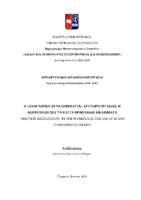| dc.contributor.advisor | Μήτρου, Λίλιαν | |
| dc.contributor.author | Παπαστάμου, Αγγελική | |
| dc.date.accessioned | 2025-08-26T10:49:25Z | |
| dc.date.available | 2025-08-26T10:49:25Z | |
| dc.date.issued | 2025-06 | |
| dc.identifier.uri | https://dione.lib.unipi.gr/xmlui/handle/unipi/18065 | |
| dc.description.abstract | Η παρούσα διπλωµατική εργασία εξετάζει τα συστήµατα ΤΝ τα οποία αξιοποιούνται για
την αναγνώριση συναισθήµατος στο χώρο εργασίας. Αρχικά, παρουσιάζεται η προσπάθεια
ορισµού της ΤΝ και βασικές έννοιες όπως οι αλγόριθµοι και η εξόρυξη δεδοµένων. Στη
συνέχεια, αναλύεται η ΤΝ αναγνώρισης συναισθηµάτων, δηλαδή η ικανότητα των
συστηµάτων ΤΝ να ανιχνεύουν, να κατανοούν και να ερµηνεύουν τα ανθρώπινα
συναισθήµατα, µέσω εκφράσεων προσώπου, ήχου και άλλων βιοµετρικών δεδοµένων.
Μετέπειτα, παρατίθεται η χρήση αυτών των τεχνολογιών στον χώρο εργασίας, όπως στη
διαδικασία πρόσληψης, στην παρακολούθηση των εργαζοµένων και ποιες εταιρίες
αξιοποιούν τα συστήµατα αυτά. Τονίζεται, τόσο η δυναµική των συστηµάτων και τα πιθανά
οφέλη για εργοδότες και εργαζόµενους, όσο και οι αρνητικές απόψεις των εργαζοµένων
σχετικά µε αυτά. Το τέταρτο κεφάλαιο εξετάζει τις νοµικές διαστάσεις της χρήσης ΤΝ
αναγνώρισης συναισθηµάτων, εστιάζοντας σε θεµελιώδη δικαιώµατα όπως η ανθρώπινη
αξιοπρέπεια, η ελευθερία έκφρασης, η ισότητα, η ιδιωτικότητα και η προστασία των
προσωπικών δεδοµένων. Ειδική αναφορά γίνεται στην ερµηνεία των συναισθηµατικών
δεδοµένων ως ενδεχοµένως ευαίσθητων προσωπικών δεδοµένων κατά το ΓΚΠΔ. Το πέµπτο
κεφάλαιο επικεντρώνεται στο νέο Κανονισµό για την ΤΝ της ΕΕ, αναλύοντας την
προσέγγιση βάσει κινδύνου και τις κατηγορίες απαγορευµένων και υψηλού κινδύνου
συστηµάτων, επικεντρώνοντας στην απαγόρευση την συστηµάτων ΤΝ αναγνώρισης
συναισθήµατος στο χώρο εργασίας. Παρά την πρόβλεψη του Κανονισµού για απαγόρευση
της χρήσης συστηµάτων ΤΝ αναγνώρισης συναισθηµάτων στον χώρο εργασίας, η εργασία
εντοπίζει ερµηνευτικές ασάφειες, νοµοθετικά κενά και προβληµατικά σηµεία ως προς την
Πράξη για την ΤΝ. Τέλος, η εργασία ολοκληρώνεται µε συµπεράσµατα και
προβληµατισµούς σχετικά την εγκυρότητα των συστηµάτων και τους κινδύνους που
εγείρονται για τα δικαιώµατα των εργαζοµένων αλλά και αναφορικά µε τα ασαφή σηµεία
του ισχύοντος νοµοθετικού πλαισίου για την ΤΝ, τονίζοντας τον ανθρωποκεντρικό
χαρακτήρα της νοµοθετικής προσέγγισης που θα πρέπει να ακολουθείται στην ΕΕ,
προκειµένου η ΤΝ να υπηρετεί τον άνθρωπο – και όχι το αντίστροφο. | el |
| dc.format.extent | 97 | el |
| dc.language.iso | el | el |
| dc.publisher | Πανεπιστήμιο Πειραιώς | el |
| dc.rights | Αναφορά Δημιουργού-Μη Εμπορική Χρήση-Όχι Παράγωγα Έργα 3.0 Ελλάδα | * |
| dc.rights.uri | http://creativecommons.org/licenses/by-nc-nd/3.0/gr/ | * |
| dc.title | Η «αναγνώριση συναισθήματος» στο χώρο εργασίας : η αξιοποίηση της ΤΝ και τα θεμελιώδη δικαιώματα | el |
| dc.title.alternative | “Emotion recognition” in the workplace : the use of AI and fundamental rights | el |
| dc.type | Master Thesis | el |
| dc.contributor.department | Σχολή Τεχνολογιών Πληροφορικής και Επικοινωνιών. Τμήμα Ψηφιακών Συστημάτων | el |
| dc.description.abstractEN | This thesis examines AI systems that are used for emotion recognition in the workplace. First,
the attempt to define AI and basic concepts such as algorithms and data mining are presented.
Emotion recognition AI, i.e. the ability of AI systems to detect, understand and interpret human
emotions, through facial expressions, sound and other biometric parameters, is then analyzed.
Next, the use of these technologies in the workplace is listed, such as in the recruitment process,
employee monitoring, and which companies are using these systems. It emphasizes both the
dynamics of the systems and the potential benefits for employers and employees, as well as the
negative views of employees regarding them. The fourth chapter examines the legal dimensions
of the use of AI to recognize emotions, focusing on fundamental rights such as human dignity,
freedom of expression, equality, privacy and the protection of personal data. Special reference is
made to the interpretation of emotional data as potentially sensitive personal data under the
GDPR. The fifth chapter focuses on the new EU AI Regulation, analysing the risk-based approach
and the categories of prohibited and high-risk systems, focusing on banning AI emotion
recognition systems in the workplace. Despite the Regulation's provision for a ban on the use of
AI systems for recognizing emotions in the workplace, the paper identifies interpretative
ambiguities, legislative gaps and problematic points regarding the AI Act. Finally, the paper
concludes with conclusions and reflections on the validity of systems and the risks they pose to
workers' rights, as well as on the unclear points of the current legislative framework for AI,
highlighting the human-centric nature of the legislative approach that should be followed in the
EU, in order for AI to serve humans – and not the other way around. | el |
| dc.contributor.master | Δίκαιο και Τεχνολογίες Πληροφορικής και Επικοινωνιών (MSc in Law and Information and Communication Technologies) | el |
| dc.subject.keyword | Τεχνητή Νοηµοσύνη (ΤΝ) | el |
| dc.subject.keyword | Τεχνητή Νοηµοσύνη (ΤΝ) αναγνώρισης συναισθηµάτων | el |
| dc.subject.keyword | Χώρος εργασίας | el |
| dc.subject.keyword | Θεµελιώδη δικαιώµατα | el |
| dc.subject.keyword | Πράξη την Τεχνητή Νοηµοσύνη (ΤΝ) | el |
| dc.date.defense | 2025-07 | |



